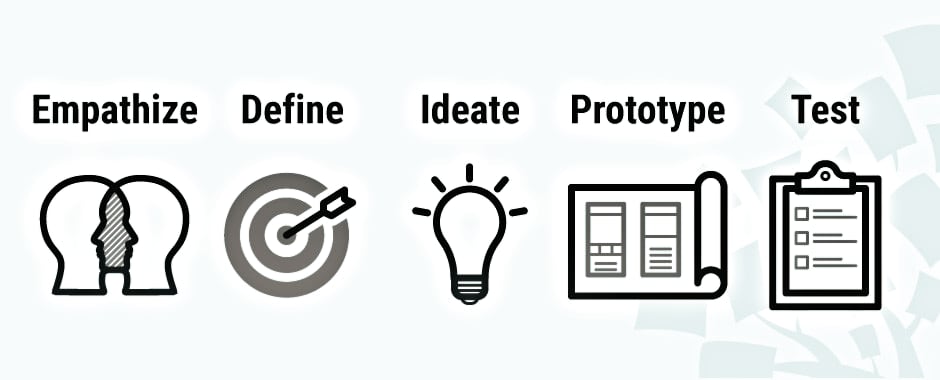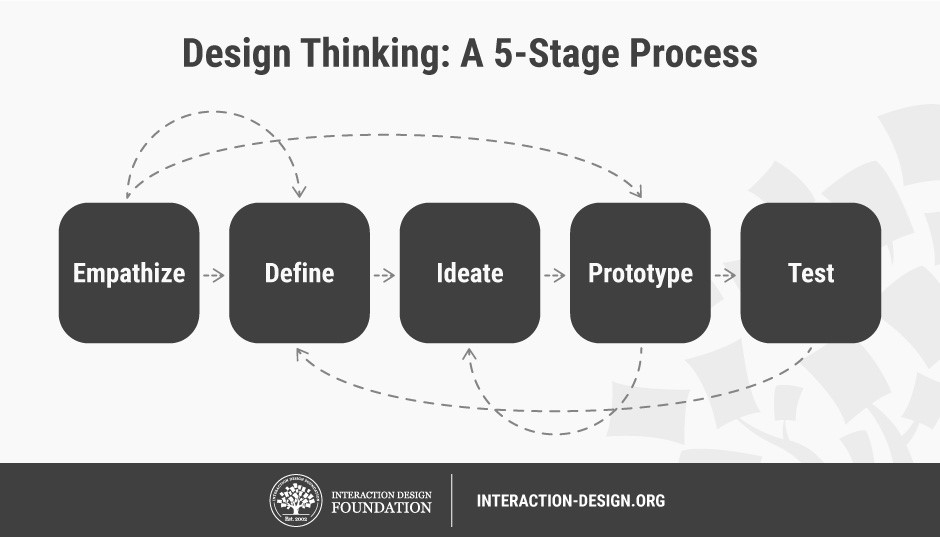Design Thinking

Design thinking is a non-linear, iterative process which seeks to understand users, challenge assumptions, redefine problems and create innovative solutions to prototype and test. The method consists of 5 phases—Empathize, Define, Ideate, Prototype and Test and is most useful when you want to tackle problems that are ill-defined or unknown.
Over recent decades, it has become crucial to develop and refine skills which allow us to understand and act on rapid changes in our environment and behavior. The world has become increasingly interconnected and complex, and design thinking offers a means to grapple with all this change in a more human-centric manner.

Design teams use design thinking to tackle ill-defined or unknown problems (otherwise known as wicked problems) because the process reframes these problems in human-centric ways, and allows designers to focus on what’s most important for users. Design thinking offers us a means to think outside the box and also dig that bit deeper into problem solving. It helps designers carry out the right kind of research, create prototypes and test out products and services to uncover new ways to meet users’ needs.
The design thinking process has become increasingly popular over the last few decades because it was key to the success of many high-profile, global organizations—companies such as Google, Apple and Airbnb have wielded it to notable effect, for example. This outside the box thinking is now taught at leading universities across the world and is encouraged at every level of business.
In his 2009 TED talk, Design Thinking pioneer Tim Brown discusses Design Thinking’s value in solving very complex challenges.
Design thinking improves the world around us every day because of its ability to generate ground-breaking solutions in a disruptive and innovative way. Design thinking is more than just a process, it opens up an entirely new way to think, and offers a collection of hands-on methods to help you apply this new mindset.
The Five Stages of Design Thinking
The Hasso Plattner Institute of Design at Stanford, commonly known as the d.school, describes design thinking as a five-stage process. It’s important to note these stages are not always sequential and designers can often run the stages in parallel, out of order and repeat them in an iterative fashion.
The various stages of design thinking should be understood as different modes which contribute to the entire design project, rather than sequential steps. The ultimate goal throughout is to derive as deep an understanding of the product and its users as possible.

Stage 1: Empathize—Research Your Users' Needs The first stage of the design thinking process allows you to gain an empathetic understanding of the problem you’re trying to solve, typically through user research. Empathy is crucial to a human-centered design process like design thinking because it allows you to set aside your own assumptions about the world and gain real insight into users and their needs.
Stage 2: Define—State Your Users' Needs and Problems In the Define stage, you accumulate the information you created and gathered during the Empathize stage. You analyze your observations and synthesize them to define the core problems you and your team have identified so far. You should always seek to define the problem statement in a human-centered manner as you do this.
Stage 3: Ideate—Challenge Assumptions and Create Ideas Designers are ready to generate ideas as they reach the third stage of design thinking. The solid background of knowledge from the first two phases means you can start to “think outside the box”, look for alternative ways to view the problem and identify innovative solutions to the problem statement you’ve created.
Stage 4: Prototype—Start to Create Solutions This is an experimental phase, and the aim is to identify the best possible solution for each of the problems identified during the first three stages. Design teams will produce a number of inexpensive, scaled-down versions of the product (or specific features found within the product) to investigate the problem solutions generated in the previous stage.
Stage 5: Test—Try Your Solutions Out Designers or evaluators rigorously test the complete product using the best solutions identified in the Prototype phase. This is the final phase of the model but, in an iterative process such as design thinking, the results generated are often used to redefine one or more further problems. Designers can then choose to return to previous stages in the process to make further iterations, alterations and refinements to rule out alternative solutions.
The Origins of Design Thinking
Both the industrial revolution and World War II pushed the boundaries of what we thought was technologically possible. Engineers, architects and industrial designers—as well as cognitive scientists—then began to converge on the issues of collective problem solving, driven by the significant societal changes that took place at that time. Design thinking emerged, or should we say converged, out of the muddy waters of this chaos from the 50s and 60s onwards.
Cognitive scientist and Nobel Prize laureate Herbert A. Simon was the first to mention design thinking as a way of thinking in his 1969 book, The Sciences of the Artificial. He then went on to contribute many ideas throughout the 70s which are now regarded as principles of design thinking.


